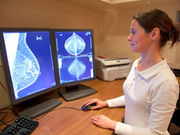Elevated recurrence rate during extended follow-up for patients with no axillary involvement, + nodes
WEDNESDAY, Jan. 27, 2016 (HealthDay News) — Breast cancer patients with estrogen receptor (ER)-positive disease have elevated annualized hazards of recurrence during extended follow-up, according to a study published online Jan. 18 in the Journal of Clinical Oncology.
Marco Colleoni, M.D., from the European Institute of Oncology in Milan, and colleagues randomized 4,105 patients with breast cancer between 1978 and 1985. The authors estimated the annualized hazards for breast cancer-free interval, disease-free survival, and overall survival during a median follow-up of 24 years.
The researchers found that the annualized hazard of recurrence was highest during the first five years (10.4 percent) for the entire group, with a peak between years one and two (15.2 percent). Patients with ER-positive disease had a lower annualized hazard than those with ER-negative disease during the first five years (9.9 versus 11.5 percent; P = 0.01). Beyond five years the hazards increased for patients with ER-positive disease (P < 0.001). The annualized hazards of recurrence remained elevated and were fairly stable beyond 10 years for patients with ER-positive disease, even for those without axillary involvement (2.0, 2.1, and 1.1 percent for years 10 to 15, 15 to 20, and 20 to 25, respectively) and those with one to three positive nodes (3.0, 3.5, and 1.5 percent, respectively).
“Strategies for follow-up and treatments to prevent recurrences may be most efficiently applied and studied in patients with ER-positive disease followed for a long period of time,” the authors write.
Several authors disclosed financial ties to the pharmaceutical industry.
Copyright © 2016 HealthDay. All rights reserved.








